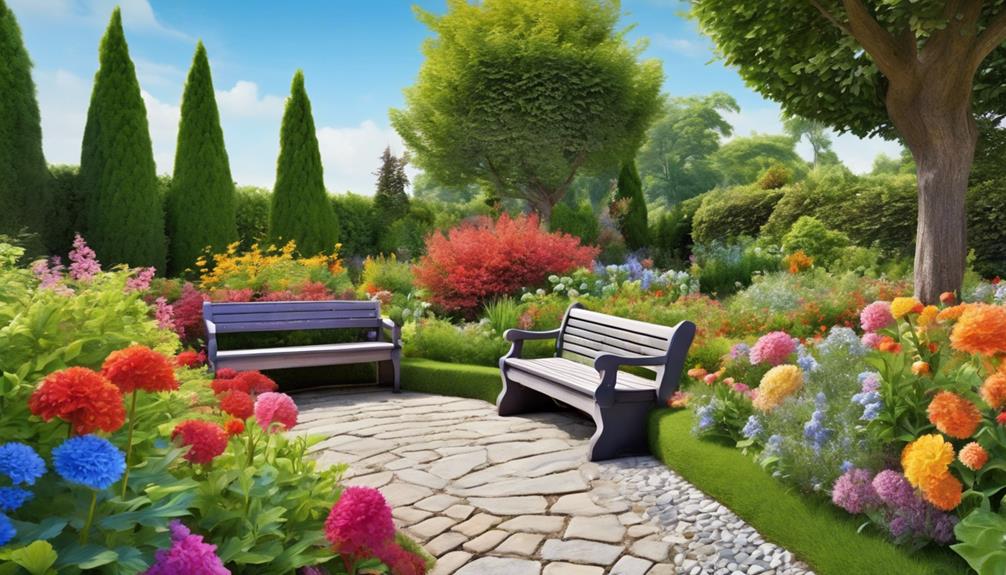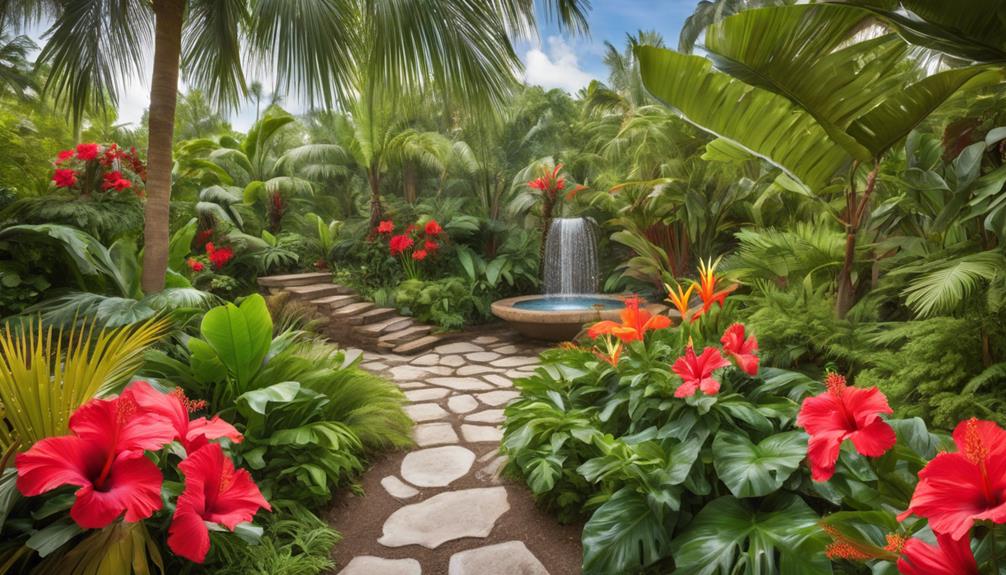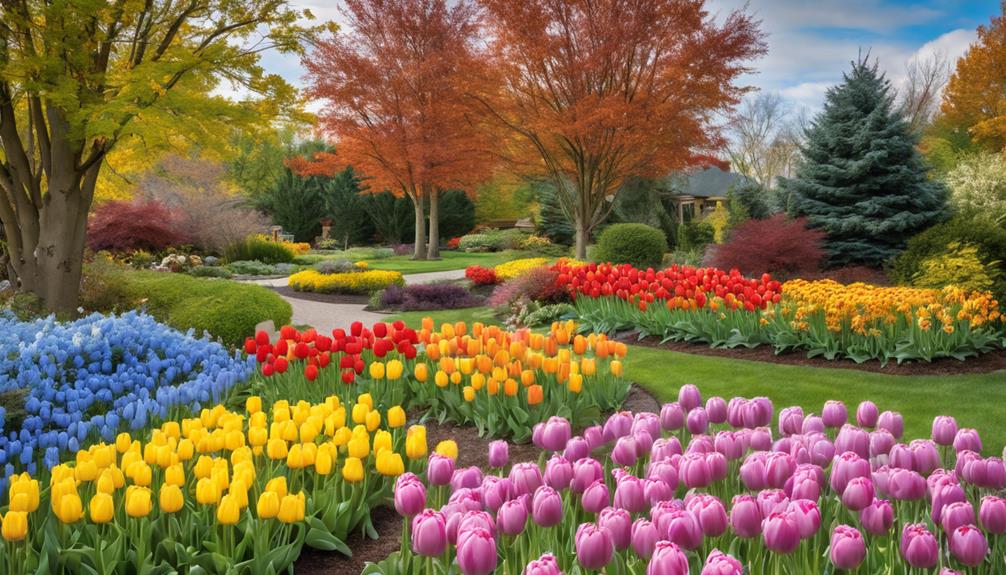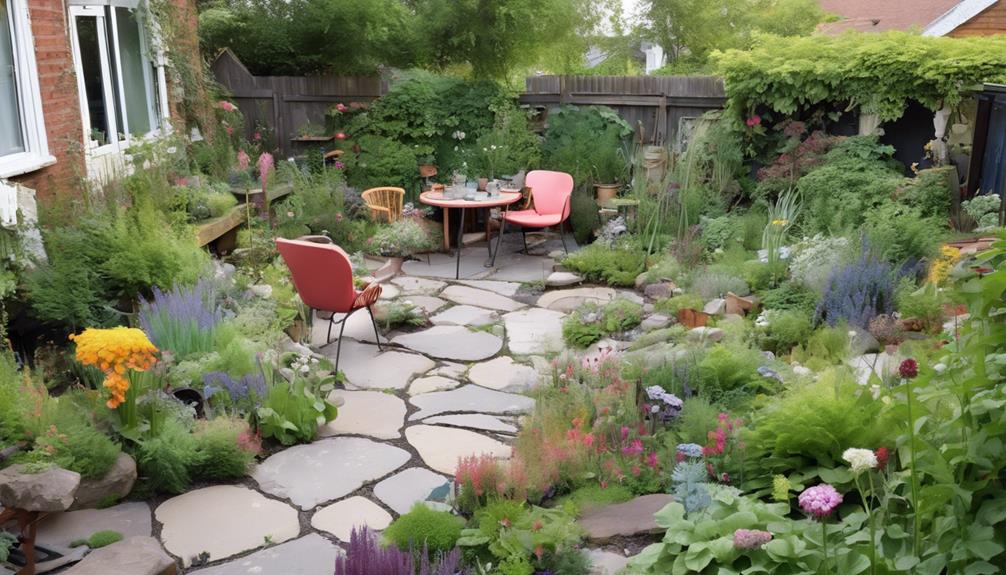
Why Choose Rustic Garden Designs for Countryside Homes?
18 September 2024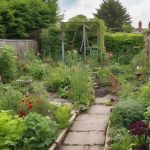
Common Garden Design Mistakes Beginners Make
18 September 2024To enhance curb appeal, consider three standout garden designs: Formal Gardens, Cottage Gardens, and Modern Minimalist Gardens.
Formal Gardens feature structured layouts with symmetrical plantings and defined pathways, exuding elegance while increasing property value.
Cottage Gardens create a charming atmosphere through a relaxed mix of flowers, herbs, and vegetables, supporting biodiversity and inviting wildlife.
Meanwhile, Modern Minimalist Gardens adopt clean lines and simple plant selections, promoting tranquillity with sustainable materials.
Each design offers unique benefits to elevate your home's exterior. Explore these styles further to discover the perfect fit for your property.
Garden Design Essentials Explained
Effective garden design hinges on a well-considered colour scheme and thoughtful plant selection.
A harmonious colour palette can create visual interest and set the tone for your outdoor space, while choosing the right plants ensures sustainability and seasonal appeal.
Color Scheme Importance
How can a well-chosen colour scheme transform a garden from ordinary to extraordinary? The strategic use of colour not only enhances visual appeal but also evokes emotion, setting the tone for the entire landscape.
A harmonious palette can unify disparate elements, guiding the eye through the space and creating focal points that draw attention. Utilising complementary colours can amplify the vibrancy of blooms, while analogous shades promote a sense of tranquillity.
In addition, seasonal variations in colour can maintain interest throughout the year, ensuring that the garden evolves over time. Careful consideration of colour can also influence perceived scale and depth, ultimately enriching the overall aesthetic.
Mastering colour schemes is crucial for any garden designer aiming to boost curb appeal and create an enchanting outdoor sanctuary.
Plant Selection Tips
Selecting the right plants is a fundamental aspect of garden design that can greatly enhance both the aesthetic and functional qualities of an outdoor space.
To achieve mastery in plant selection, consider climate, soil type, and sunlight exposure. Choose native species that thrive in your region, as they require less maintenance and support local ecosystems.
Incorporate a mix of perennials and annuals to ensure year-round interest and diverse textures. Pay attention to plant size and growth habits to maintain balance and harmony in your design.
Furthermore, consider seasonal blooming cycles to create a dynamic visual narrative. Ultimately, prioritise plants with complementary colours and forms to elevate curb appeal, confirming a cohesive and inviting landscape that resonates with the viewer.
Plant Selection Strategies
Effective plant selection is essential for creating a visually appealing garden that enhances curb appeal.
Key factors to take into account include soil quality and type, sunlight exposure requirements, and watering frequency considerations, all of which greatly influence plant health and growth.
Soil Quality and Type
Soil quality and type are critical factors that greatly influence plant selection strategies in garden design.
Understanding the characteristics of your soil is essential for ensuring ideal plant health and aesthetic appeal.
Consider the following elements when evaluating your garden's soil:
- Texture: Sandy, loamy, or clay-heavy soils affect drainage and nutrient retention.
- pH Level: Acidic or alkaline soils influence plant availability and growth.
- Nutrient Content: Assessing macronutrients such as nitrogen, phosphorus, and potassium ensures robust plant development.
- Moisture Retention: Understanding how well your soil retains moisture impacts irrigation strategies.
Sunlight Exposure Requirements
Understanding soil quality and type provides a foundation for making informed decisions about plant selection, particularly regarding sunlight exposure requirements.
Different plants thrive under varying light conditions, and understanding these needs is essential for ideal garden design. When selecting plants, consider the following factors:
- Full Sun: Plants like sunflowers and lavender flourish in unfiltered sunlight for six or more hours daily.
- Partial Shade: Hostas and ferns perform well with dappled sunlight or three to six hours of direct light.
- Full Shade: Consider shade-loving plants like astilbes and fuchsia, which thrive in limited light.
- Variable Light: Choose versatile options like daylilies that can adapt to multiple light conditions.
Aligning plant selection with sunlight exposure guarantees a vibrant and sustainable garden.
Watering Frequency Considerations
Watering frequency is a critical factor in plant selection strategies, as it directly impacts plant health and growth. Understanding the specific needs of plants regarding moisture can guide your choices and enhance curb appeal.
Consider the following aspects when selecting plants:
- Drought-tolerant species: Ideal for low-maintenance gardens, these plants require less frequent watering.
- Moisture-loving plants: They thrive in consistently damp conditions and necessitate regular watering.
- Seasonal variations: Acknowledge how plant requirements change with the seasons, which can influence watering schedules.
- Soil type: Different soils retain moisture differently; sandy soils drain quickly, whereas clay retains water.
Choose the Right Tools
Choosing the right tools is crucial for effective garden design and maintenance.
Appropriate tools facilitate initial planning and design, support mulching for moisture retention, and enable creative vertical gardening methods.
Initial Planning and Design
When embarking on the expedition of garden design, equipping yourself with the right tools is essential for translating ideas into reality.
A well-thought-out plan requires not only creativity but also precision in execution. The following tools will serve as fundamental companions in your design adventure:
- Sketchpad and pencils for drafting initial layouts and ideas.
- Measuring tape to ensure accurate dimensions and spacing.
- Garden design software to visualise and manipulate your landscape digitally.
- Mood boards to gather inspiration and colour palettes that resonate with your vision.
Mulching for Moisture Retention
Effective mulching is crucial for maintaining soil moisture, and selecting the right tools can significantly enhance this process. The appropriate tools not only simplify application but also ensure that your mulch performs at its best.
Consider incorporating the following essential implements into your gardening toolkit:
- Mulching Fork: Ideal for evenly distributing organic material.
- Garden Spreader: Ensures a uniform layer of mulch, promoting consistent moisture retention.
- Weed Barrier Fabric: Aids in suppressing unwanted growth while allowing water to permeate.
- Rake: Perfect for levelling and smoothing the mulch surface for an aesthetically pleasing finish.
Vertical Gardening Methods
In the realm of modern gardening, vertical gardening methods have gained prominence for their ability to optimise space while enhancing aesthetic appeal.
Selecting the right tools is essential for successful implementation. A well-curated toolkit can transform your vertical gardening experience, ensuring both functionality and beauty.
- Sturdy trellises to support climbing plants and create striking vertical lines.
- Vertical planters designed for efficient space utilisation and irrigation.
- Hanging pots that introduce a cascade of colour and texture.
- Garden hooks for easy organisation of tools and accessories.
Increased Property Value
A well-designed garden not only enhances the visual appeal of a property but also significantly contributes to its overall market value. Research indicates that homes with professionally landscaped gardens can experience property values increase by up to 20%. A strategic garden design enhances outdoor living spaces, inviting potential buyers to envision a lifestyle that incorporates nature.
| Design Element | Impact on Value | Maintenance Level |
|---|---|---|
| Native Planting | High | Low |
| Hardscaping Features | Moderate to High | Moderate |
| Seasonal Blooms | Moderate | High |
| Edible Gardens | Moderate | Moderate to High |
Investing in thoughtful garden design not only elevates aesthetic appeal but also represents a wise financial decision, ensuring long-term value for homeowners.
Seasonal Planting Strategies
Seasonal planting strategies are vital for maximising garden aesthetics and functionality throughout the year.
Integrating native plants not only enhances biodiversity but also supports local ecosystems, while companion planting can promote growth and yield.
Furthermore, employing effective pest management techniques ensures a healthy garden, contributing to an appealing landscape that increases curb appeal.
Native Plant Integration
Many homeowners are discovering the advantages of integrating native plants into their gardens as a means to enhance curb appeal while supporting local ecosystems.
By strategically selecting seasonal native plants, you can create a vibrant, sustainable landscape that flourishes throughout the year.
Consider incorporating:
- Echinacea purpurea (Purple Coneflower) for summer splendour and pollinator attraction.
- Aster novae-angliae (New England Aster) to add bursts of colour in the autumn.
- Asclepias tuberosa (Butterfly Weed) to entice butterflies and provide valuable nectar.
- Carex pensylvanica (Pennsylvania Sedge) for lush green ground cover that thrives in various conditions.
These choices not only enhance visual appeal but also promote biodiversity and resilience, ultimately positioning your garden as an exemplar of ecological stewardship.
Companion Planting Benefits
Companion planting offers a strategic approach to gardening that optimises the benefits of plant relationships while enhancing overall garden health.
By carefully selecting plants that thrive together, gardeners can create a harmonious ecosystem that fosters growth and vitality.
- Nitrogen Fixation: Legumes, such as clover, enrich the soil, promoting healthier neighbouring plants.
- Space Optimisation: Taller plants, like sunflowers, can provide shade for more delicate species, maximising garden space.
- Improved Pollination: Flowers like marigolds attract beneficial insects, increasing pollination rates for nearby crops.
- Disease Resistance: Certain combinations can deter diseases, creating a robust garden environment.
Mastering companion planting not only enhances your garden's aesthetic appeal but also cultivates a thriving biosphere that improves its overall productivity.
Pest Management Techniques
Effective pest management is key to maintaining a healthy garden, and implementing seasonal planting strategies can greatly reduce pest populations while promoting plant health.
By strategically selecting and timing your plantings, you can create an ecosystem that naturally deters pests.
Consider these seasonal planting techniques:
- Early bloomers: Attract beneficial insects that prey on pests.
- Diversity planting: Incorporate a variety of species to confuse and disrupt pest cycles.
- Crop rotation: Prevent soil-borne pests and diseases from establishing.
- Companion crops: Utilise plants that repel pests or improve the growth of neighbouring plants.
These methods not only enhance the health of your garden but also cultivate a sustainable environment that elevates curb appeal through vibrant, thriving landscapes.
Pest Infestations and Remedies
Pest infestations can undermine even the most well-designed gardens, making effective management vital for maintaining curb appeal.
Techniques such as adjusting soil pH and optimising watering systems play significant roles in creating an environment less conducive to pests.
Balancing soil pH is particularly important, as it influences plant health and resilience against infestations.
Soil Ph Adjustment Techniques
How can adjusting soil pH contribute to healthier plants and reduced pest infestations? Proper soil pH is essential for nutrient availability, which directly impacts plant health.
When plants thrive, they become more resilient to pests. Implementing soil pH adjustment techniques can create an inhospitable environment for harmful insects.
Consider these effective methods:
- Lime Application: Raises pH levels, fostering nutrient uptake in acidic soils.
- Sulphur Supplement: Lowers pH in alkaline soils, enhancing nutrient availability for acid-loving plants.
- Compost Usage: Improves soil structure and introduces beneficial microbes, helping to regulate pH naturally.
- Regular Testing: Ensures precise adjustments, promoting ideal plant health.
Watering System Optimization
A well-designed watering system plays a crucial role in maintaining plant health and mitigating pest infestations in the garden.
An optimised watering approach guarantees that plants receive adequate moisture while reducing conditions conducive to pests.
Consider implementing the following strategies:
- Drip Irrigation: Delivers water directly to the root zone, minimising evaporation and fungal growth.
- Smart Timers: Automate watering schedules, guaranteeing consistent moisture levels without over-saturation.
- Mulching: Retains soil moisture and suppresses weed growth, which can attract pests.
- Rainwater Harvesting: Utilises natural rainfall, reducing reliance on municipal water and lowering costs.
Soil Ph Balancing Techniques
Maintaining the proper pH balance in garden soil is essential for promoting healthy plant growth and preventing pest infestations. An ideal pH range allows plants to efficiently absorb nutrients, thereby reducing their susceptibility to pests.
To effectively balance soil pH, consider the following techniques:
- Testing soil pH: Utilise a reliable pH metre or test kit to determine current levels.
- Amending soil: Incorporate lime to raise pH or sulphur to lower it, based on test results.
- Organic matter: Add compost to enrich soil, fostering a robust ecosystem that deters pests.
- Regular monitoring: Consistently check soil pH, adjusting amendments as necessary to maintain optimal conditions.
Employing these techniques guarantees a thriving garden, ultimately enhancing curb appeal.
Why Choose TKL Birmingham Gardener
Choosing the right gardener can greatly impact the overall appearance and atmosphere of your garden, and TKL Birmingham Gardener stands out for a multitude of reasons.
With a commitment to exceptional craftsmanship, TKL employs a team of skilled horticulturists who possess extensive knowledge of native plants and sustainable gardening practices. Their personalised approach ensures that each design reflects the homeowner's vision while enhancing the property's aesthetic appeal.
TKL's meticulous attention to detail guarantees that every element, from plant selection to hardscaping, is executed with precision. Furthermore, their dedication to ongoing maintenance ensures that your garden remains vibrant and thriving throughout the seasons.
Common Garden Design Questions
Selecting the right gardener, such as TKL Birmingham Gardener, lays the foundation for a well-designed outdoor space.
However, many homeowners still grapple with common garden design queries. Key inquiries often revolve around plant selection, layout, and seasonal maintenance. Homeowners frequently ask which plants are best suited to their climate and soil conditions, highlighting the necessity for local expertise.
Furthermore, questions about balancing aesthetics with functionality are crucial; achieving a harmonious blend of colour, texture, and structure can significantly enhance curb appeal.
Seasonal considerations, such as which flowers bloom at different times, also play a fundamental role in planning. Addressing these queries is essential for cultivating a garden that not only enhances beauty but also thrives sustainably throughout the year.
Future Gardening Trends
As homeowners increasingly seek to enhance their outdoor spaces, the future of gardening trends reflects a growing emphasis on sustainability and technology.
This shift is characterised by innovative practices that harmonise nature with modern living. Key trends to watch include:
- Vertical gardens: Transforming walls into lush, green canvases that optimise space.
- Smart irrigation systems: Utilising sensors and automation to conserve water and improve plant health.
- Native planting: Emphasising local flora to support biodiversity and reduce maintenance.
- Edible landscapes: Integrating fruits, vegetables, and herbs into ornamental designs, promoting self-sufficiency.
As these trends gain momentum, they not only elevate aesthetic appeal but also foster environmental stewardship, making gardens more functional and sustainable.
Mastering these elements will ensure a vibrant, future-ready outdoor space.

